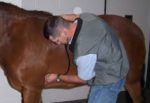 Your emergency kit likely includes a stethoscope — a highly valuable piece of equipment during any urgent health situation. Knowing your horse’s normal heart rate and gut sounds beforehand will allow you to better assess the seriousness of the situation — so use your stethoscope now.
Your emergency kit likely includes a stethoscope — a highly valuable piece of equipment during any urgent health situation. Knowing your horse’s normal heart rate and gut sounds beforehand will allow you to better assess the seriousness of the situation — so use your stethoscope now.
A resting pulse is typically between 32 and 40 beats per minute (ponies’ are slightly higher). Place the stethoscope in front of the girth area, just behind the elbow. Using the sweep second hand on your watch or a stop watch (usually a feature on your cell phone), count the number of beats for 30 seconds and double it to get beats per minute. Measure at various times of day, before and after eating, and at any change in circumstances or activity level; this will give you a clear idea of how your horse generally responds to his environment. Marked deviation from normal (without obvious explanation such as exercise) can indicate the presence of infection, pain, or illness.
Your stethoscope is especially useful for listening to gut sounds. It is normal and healthy for sounds to come from the digestive tract due to the movement of feed, gas, and fluid. Intestines are made of muscles; processing forage continuously provides the necessary exercise to keep these muscles in good condition. Normally, the sounds will be low in pitch with some growling. Colic occurs when there is a change within the intestines, ordinarily due to obstruction, gas, or torsion, and sounds change or stop altogether. If you don’t hear any noise, or if the sounds have become higher pitched, significantly slowed, or sound hollow, it likely indicates colic and you should contact your vet immediately.
Practice listening to four areas of the gut: along the upper barrel and the lower flank area on both sides. Generally speaking, sounds from the upper left come from the small colon and tend to be high pitched and of short duration. The lower left has sounds from the large colon. On the upper right, the sounds come from the large colon and cecum whereas the lower right has the large colon. However, the point of origin for gut sounds is not completely predictable; the important thing is to identify a variation from your horse’s normal sounds.
Deviations from normal in pulse or gut sounds may have many possible explanations, so unless you have extensive experience, you should never put yourself in the position of diagnosing colic or other disorders. But you can be a valuable resource to your veterinarian if you know what is normal for your horse and can identify a change, before illness happens.
For more information www.gettyequinenutrition.biz



